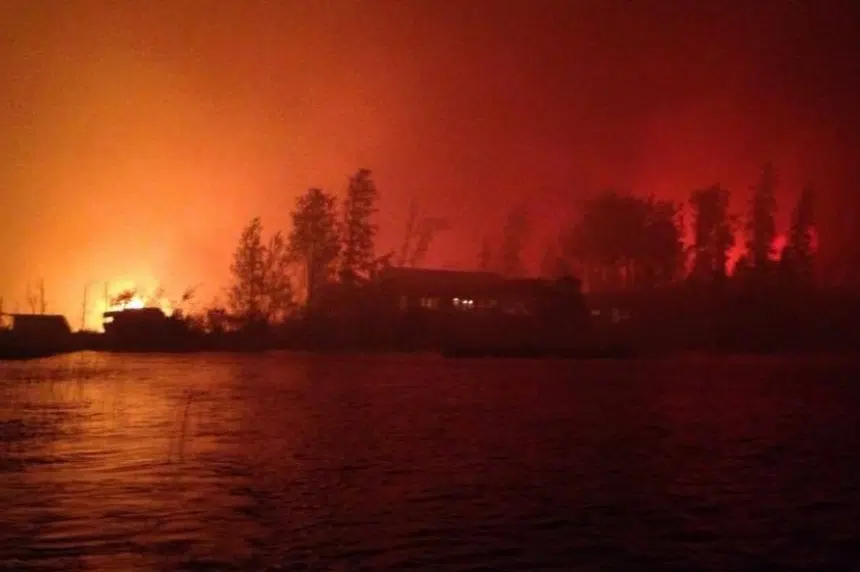Communities around Lac La Ronge are slowly evacuating as fire continues to threaten their homes.
Two dozen full buses carried 1,078 people out of La Ronge, Air Ronge and Lac La Ronge Indian Band just before 1 a.m. Sunday while many others drove out in their own cars. Buses are destined for Cold Lake, Alta.
The Town of La Ronge issued a mandatory evacuation order for anyone living north of the Montreal River Bridge, Saturday night, while a general evacuation was advised for all of La Ronge, Air Ronge and Lac La Ronge Indian Band. The Egg fire has moved to within eight kilometres north, to the east side of Hives Lake. Meanwhile, fire is within 500 metres of Hall Lake, Sikachu and Clam Lake Bridge and is a direct threat to the communities, according to Lac La Ronge Indian Band Chief Tammy Cook-Searson.
The largest Saskatchewan wildfire evacuation notice to date affects more than 7,900 people, and will more than double the current 5,588 northern Saskatchewan evacuees.
“So socked in with smoke we can’t see across our lake,” said Jenni Willems, who is helping her father evacuate his home near Lamp Lake, 10 kilometres north of La Ronge.
“I wouldn’t say scary. You grow up in the north, you’re surrounded by forest fires, you’re kind of mentally prepared for that, but to actually see it happening is another thing all together.”
La Ronge residents line up for gas Saturday evening following the evacuation notice. Photo courtesy Jennifer Willems
La Ronge evacuees who do not have a place to stay are being sent to an evacuation facility in Cold Lake, Alta. The Red Cross will coordinate the evacuation centre with additional support from the Canadian Armed Forces. Facilities in Cold Lake can house up to 5,000 people but the province expects many residents to stay with family and friends, according to Emergency Management and Fire Safety director Duane McKay.
Another bus will take 64 people from Hall Lake, including Sikachu Lake and Clam Lake Bridge, to the Margo Fournier Center in Prince Albert.
Premier Brad Wall said he spoke with Prime Minister Stephen Harper around 3 p.m. who promised CAF will help in Cold Lake. He said evacuation plans have been in the works since fires began to approach the community.
A notice sent out to residents asks them to leave with “a sense of purpose and urgency, but not panic.”
The primary evacuation route is Highway 2 south while Highway 165 east towards Creighton is also an option. Highway crews are watching junctions and will inform travelers of road closures and alternate routes.
There is smoke and some small fires along Highway 2.
People who need transportation can register at the JRMCC hall and area on Far Reserve. Buses will be provided. People are asked to only bring one bag, all necessary medication and no pets. Officials will stay behind to look after pets.
The government of Saskatchewan’s Wildfire Management Branch has deployed additional assets to protect the community’s homes and infrastructure. Fire crews from Prince Albert and Warman are also en route.
Last night, fires burned down three buildings in Wadin Bay, which is 25 kilometres north of La Ronge. Homes were also damaged in Weyakwin and Montreal Lake, where a state of emergency has been declared.
Willems, who lives in Saskatoon, said they hauled away any flammable material and buried larger equipment like snowmobiles in sand.
She said they set up a sprinkler system but their pump quit, as did all their neighbours’ systems. She said they are waiting for a new one before they leave.
She said she is relying on social media for information and photos of the fires.
There are currently 114 fires burning across northern Saskatchewan.
Follow on Twitter: @lkretzel
Posted by Tammy Cook-Searson on Saturday, July 4, 2015
This is the scene on Highway 2. It shows the steady traffic (La Ronge evacuees) heading south on Hwy 2 at Weyakwin.
Posted by Saskatchewan Highway Hotline on Saturday, July 4, 2015











